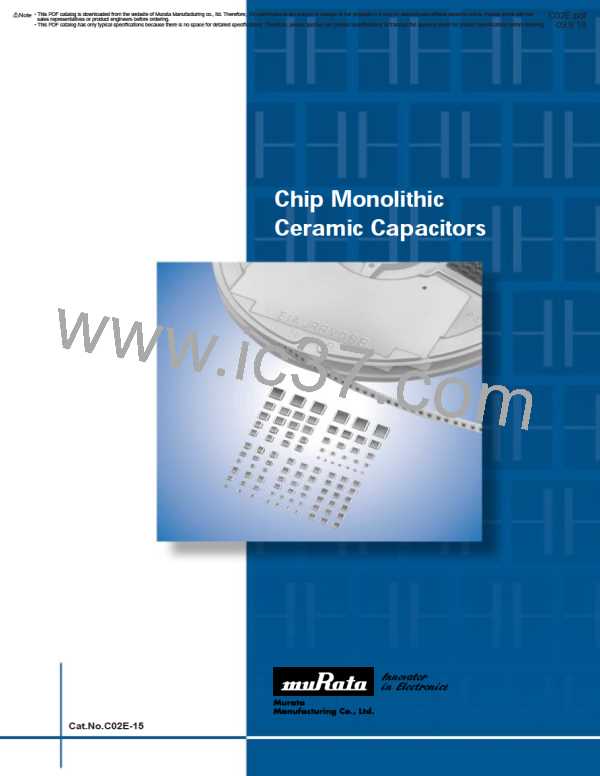• This PDF catalog is downloaded from the website of Murata Manufacturing co., ltd. Therefore, it’s specifications are subject to change or our products in it may be discontinued without advance notice. Please check with our
• Please read rating and !CAUTION (for storage, operating, rating, soldering, mounting and handling) in this catalog to prevent smoking and/or burning, etc.
!Note
!Note
C02E.pdf
sales representatives or product engineers before ordering.
• This catalog has only typical specifications because there is no space for detailed specifications. Therefore, please approve our product specifications or transact the approval sheet for product specifications before ordering0. 9.9.18
• This PDF catalog has only typical specifications because there is no space for detailed specifications. Therefore, please approve our product specifications or transact the approval sheet for product specifications before ordering.
Specifications and Test Methods
Specifications
No.
1
Item
Operating
Test Method
Y55 to W125D
Y
Temperature Range
Visual inspection
Using calipers
2
3
Appearance
No defects or abnormalities
Dimensions
Within the specified dimension
No failure should be observed when DC4095V is applied
between the terminations for 1 to 5 sec., provided the charge/
discharge current is less than 50mA.
4
5
Dielectric Strength No defects or abnormalities
The insulation resistance should be measured with DC500T50V
and within 60T5 sec. of charging.
Insulation Resistance
More than 10,000MΩ
(I.R.)
6
7
Capacitance
Q
Within the specified tolerance
1,000 min.
The capacitance/Q should be measured at a frequency of
1T0.2MHz and a voltage of AC0.5 to 5V(r.m.s.)
The capacitance measurement should be made at each step
specified in Table.
Step
Temperature (D)
25T2
Min. Operating Temp.T3
25T2
Max. Operating Temp.T2
25T2
Temp. Coefficient
0T30ppm/D (Temp. Range: W25 to W125D)
0W30, Y72ppm/D (Temp. Range: Y55 to W25D)
Capacitance
Temperature
Characteristics
1
2
3
4
5
8
Solder the capacitor to the testing jig (glass epoxy board) shown
in Fig. 1.
Then apply 10N force in the direction of the arrow.
The soldering should be done using the reflow method and
should be conducted with care so that the soldering is uniform
and free of defects such as heat shock.
Adhesive Strength
of Termination
9
No removal of the terminations or other defect should occur.
10N, 10T1s
Glass Epoxy Board
Fig. 1
Appearance
Capacitance
No defects or abnormalities
Within the specified tolerance
Solder the capacitor to the test jig (glass epoxy board).
The capacitor should be subjected to a simple harmonic motion
having a total amplitude of 1.5mm, the frequency being varied
uniformly between the approximate limits of 10 and 55Hz. The
frequency range, from 10 to 55Hz and return to 10Hz, should be
traversed in approximately 1 min. This motion should be applied
for a period of 2 hrs. in each of 3 mutually perpendicular
directions (total of 6 hrs.).
11
Vibration
Resistance
Q
10
1,000 min.
Solder resist
Cu
Glass Epoxy Board
No cracking or marking defects should occur.
Solder the capacitor to the testing jig (glass epoxy board) shown
in Fig. 2.
Then apply a force in the direction shown in Fig. 3.
The soldering should be done using the reflow method and
should be conducted with care so that the soldering is uniform
and free of defects such as heat shock.
b
φ4.5
d
c
50
a
Pressurizing
20
speed : 1.0mm/s
t : 1.6
100
11 Deflection
Pressurize
R230
Dimension (mm)
LZW
(mm)
4.5Z2.0
a
3.5
b
7.0
c
2.4
d
1.0
Flexure=1
Capacitance meter
45 45
Fig. 2
(in mm)
Fig. 3
Continued on the following page.
177

 MURATA [ muRata ]
MURATA [ muRata ]